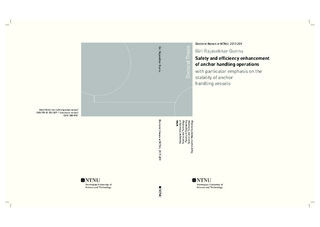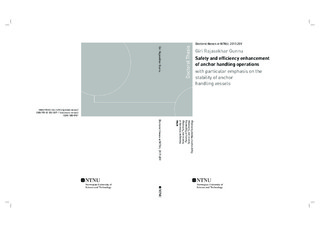| dc.description.abstract | The overall objective of this thesis is the development of a framework for enhancing the safety and efficiency of anchor handling vessels (AHVs) during anchor handling operations (AHOs). In other words, the proposed framework contributes to an optimized solution for AHVs with the objective of balancing risk and cost. An optimal strategy considering cost and safety is achieved by moving away from standard weather restriction limits to vessel-specific limits (“by focussing on safety”). With this strategy in mind, a methodology is proposed for defining vessel-specific operational limits with the goal of not compromising safety.
On 12 April 2007, the Bourbon Dolphin accident occurred in the North Sea; eight of the ship’s crew lost their lives. In general, there are stakeholders involved in these operations, for example, designers, shipping companies, operators, statutory bodies, governmental bodies, and insurance companies. This accident alarmed the public and drew the attention of government regulators and other stakeholders. These stakeholders have a role in minimizing risk and improving safety. To achieve these goals, they have their own procedures, guidelines, and standards. However, these existing procedures and international standards are not well established for mitigating risk and maintaining a safety margin for AHVs during AHOs. For this purpose, the offshore (or oil and gas) industry must improve the existing procedures or establish new procedures and methods.
Due to their characteristics, these AHOs come under the category of complex, weather-restricted marine operations, which imposes additional challenges for the vessels and the personnel involved in these operations. Therefore, the practice in the industry is that AHOs are performed up to a maximum significant wave height of 3.5 m and a mean wind velocity of 40 knots. Furthermore, AHOs contribute 10 to 20% of the total drilling well cost in offshore oil and gas exploration. The operational cost can be reduced by increasing the available weather window or operability (or reducing downtime); this reduction can be achieved by increasing operational limiting parameters related to weather. Therefore, enhancement of the safety (or minimization of the risk) and cost efficiency of AHVs during AHOs is considered a research topic. This research addresses AHV safety issues directly during AHOs and indirectly in terms of cost.
The world is not perfect. Hence, it is not possible to design vessels that are 100% safe and cost effective to handle operational loads during AHOs. Therefore, to conduct safe AHOs, a combination of better vessel selection, operational limitations, operational planning and crew training is used. Before defining operational limits, it is essential to identify the influence parameters for vessel capsizing, that is, environmental, hardware, software and human factors. These parameters can be broadly classified into two categories. The first category is related to vessel behaviour: vessel stability and vessel drift-off in a horizontal plane. The second relates to human performance – skill, knowledge, and Situational Awareness (SA) – and depends on the personnel involved in these operations, for example, an AHV’s master and deck officers, tow master, offshore installation manager (OIM), marine representative, rig winch operator and deck crew, surveyor, and other vessel deck officers. With respect to the safety and performance of AHVs, the key personnel are the AHV’s master and winch operator. In particular, the vessel master has three roles: being aware of vessel behaviour, identifying an appropriate control strategy and executing that strategy. Even a decision to stop or proceed with the operation is a responsibility of the master or of whoever is in charge of the bridge. Therefore, the personnel involved in operations must be aware of the influence of the magnitude of mooring loads and other parameters of vessel behaviour.
The key sequence of events related to the Bourbon Dolphin accident are as follows: vessel driftoff (with respect to the desired mooring line track), a large angle of attack, a large overturning moment, a large initial heeling angle (or static heeling angle) and, eventually, the vessel capsizing. First, the excessive drift-off from the planned anchor track is an initiating event related to this accident. Therefore, the progress of vessel drift and angle of attack are simulated and analysed for potentially dangerous situations. The analysis results show that insufficient positioning capability is one of the reasons behind the initiating event. For this reason, in this study, the thrustutilization plot concept was proposed. Here, the effect of the mooring line load was considered in addition to the general practice with environmental loads.
As mentioned previously, the large static heeling angle was the event immediately preceding capsizing. It is essential to assess vessel stability thoroughly in the design and analysis phase of AHOs to prevent similar accidents. Thus, the existing stability criteria are reviewed, and it is noticed that these criteria do not cover AHV stability when the vessel is subject to mooring load during the AHO. Additionally, there is no criterion to be found for monitoring stability during the operation phase. Therefore, two stability criteria are established, namely, the 1) critical static heeling angle criterion and 2) critical rolling angle criterion. The first criterion is useful in the design phase for assessing vessel allowable static heeling angle (which is a function of the thrust force, mooring load, current and wind) for a well-defined operating sea state. Moreover, this criterion is helpful for operators when assessing vessel safety status and identifying the risk mitigation (or control) strategies for preventing capsizing during the execution phase of the operation. The second criterion represents the critical dynamic rolling angle in waves for an estimated total heeling moment induced by the thrusters, mooring line, current and wind. This criterion is useful for assessing vessel stability in the analysis and planning phase of the operation.
Although the operational limits are defined in the analysis and planning phase, it is not possible to prevent vessel capsizing unless there is awareness of the vessel’s behaviour. At present, the existing on-board monitoring systems are not useful for assessing the vessel’s stability status when it is subjected to mooring load during AHOs. Therefore, in this study, an artificial neural network (ANN)-based on-board monitoring system is proposed for assessing vessel static heeling angle by considering the effect of operational parameters.
Even when the vessel’s stability margin (in terms of vessel static heeling angle) can be predicted (with a condition monitoring system), it is difficult to identify the best control strategy when the vessel is approaching capsizing. Moreover, if the operation must be performed in new areas (such as deep waters) or higher waves than are normally anticipated, such operations can enforce additional constraints on the vessel master during decision-making. To overcome these constraints, an optimization-based decision support system (DSS) is proposed for identifying the best possible set of control strategies. Although many control strategies are available, some control measures are preferable to others based on the operational situation. For this reason, a hierarchical approach is considered for finding the optimal control strategy for a given operation.
The following benefits are achieved by this study:
Improving the safety of the vessel and its crew during AHOs;
Understanding vessel handling capability under normal and failure conditions (propeller or thrusters);
Increasing the vessel’s operating weather window;
Improving the utilization of vessels;
Reducing overall costs related to rig moves and drilling operation;
Providing a clear and straightforward criterion for selecting vessels and establishing operational limits via the thrust-utilization plot concept.
Note that the framework presented in this thesis can be extended to other types of marine operations such as fish trawling, pipe laying, and crane operation. | nb_NO |

